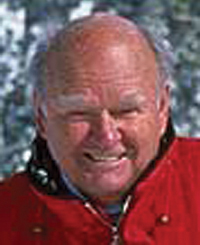For all of you out there who aren't old enough to have learned to ski riding a rope tow, let me describe one for you.
Imagine a piece of rope twice as long as from the bottom of the ski hill to the top. Made of wet hemp and spliced in half a dozen places, it ran endlessly around a drive wheel somewhere and dragged in the snow on the way up the hill. On the way down it hung loosely over a half dozen automobile wheels bolted to convenient trees. As it dragged through the snow on the way up, it absorbed moisture, and since it was made of hemp, it could absorb a lot of water. So much that it took a strong person to hold the rope as he or she was pulled up the hill.
To ride a rope tow, you stood with your hand out and grasped the rope, gradually increasing your grip until you started moving up the hill at the same rate of speed as the rope. As you got up to that velocity, your hand usually squeezed out a quart or more of water from the wet hemp. The water could only land on your ski pants or drip down your parka. The rope slowly twisted as it made its way through the sheaves on its round trip. If you wore a sweater and held the rope next to your body it automatically wrapped up your sweater in the rope. There were no safety devices on rope tows until sometime in the 1950s. Thus, when you got to the top and the rope began to climb high up into the shack where the automobile engine was running, a large part of your sweater would continue on with the rope and you would fall to the ground half-naked and scared for your life.
Despite all of that, you could ride a rope tow all day for just a couple of dollars. By dark you where so exhausted you could fall asleep in the back of your car where you lived in the ski hill parking lot on weekends.
Sure, rope tows were exhausting, wet and messy, but they were cheap. Anyone with a two dollar bill could trade it for a full day of skiing. People complained about the cleaning bills for their rope-tow-stained garments, but millions of us still took up skiing in the late 1940s and '50s. We did it because it was nonstop fun, exhausting fun, but it was nonstop nonetheless. From the time you went out and climbed into your ski gear, you could keep your skis moving across the snow all day long. Racing down or riding up, it made no difference—your skis were still wearing off the wax all day.
<
Most of the rope tow resorts were built and run by men who had vision. Dave McCoy was the king of the rope tow for a lot of years. Dave used to start his rope tows at 8 in the morning and run them until it was too dark to make turns. I used to drive over 700 miles roundtrip on a two-lane road from Manhattan Beach to Mammoth, to spend the day hanging on to one of his two rope tows. At night I slept in my truck. The friends who rode along with me bought the gas and an oil change, and they had to sleep outside in the campground. If it was snowing they slept under the picnic tables. And if it wasn't, they slept under the stars.
The cost of building a rope tow was the cost of an engine from a wrecked automobile out of a junkyard, eight or ten automobile wheels and several thousand feet of hemp rope. Hemp rope in those days was army surplus and cost 10 to 15 cents a foot, or a couple of hundred dollars in total. Discounting labor, the cost of building a rope tow was less than a thousand dollars. Then the entrepreneur used rope tow ticket earnings to eventually go into unbelievable debt by ordering his first chairlift. This led to people not being tired enough from hanging on to the rope that they could stand in the long chairlift line and complain about how far they had to drive to stand there or how the No Tell Motel had gone up to $6 a night from $5 the winter before.
The reality of economics has forced a lot of changes in the ski industry, as it has in all industries, but I know that those rope tows sure offered many opportunities for me to make funny movies of people trying to hang on to them. They also allowed me, and many others, a chance to learn how to ski at a price I could afford while I was still in high school in 1939 and earning just $3 a week delivering newspapers.






































